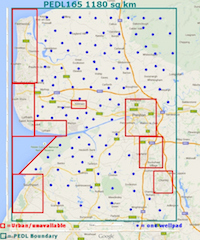We are turning our attention here to the claim repeatedly made by Cuadrilla in local press adverts and in their “community newsletter”, that the geophysical survey alone contributed around £1.5 million to the local economy through salaries and local expenditure. This is a big claim – Mark Miller even put his signature to it in a press advert in the Blackpool Gazette on 26th June 2012.
We were very interested to see whether it would stand up to scrutiny. At the Mark Menzies meeting with the regulators in St Annes, We asked Mr Miller from Cuadrilla how he arrived at the figure . In our opinion he didn’t make a very good fist of this, stretching my credulity by talking about “hundreds” of foreign workers being paid subsistence expenses in addition to the 50 local crew. We asked him to publish some figures to back the claim up. This is what PPS (Cuadrilla”s PR company) eventually sent us
Let’s start with a relatively minor issue. The individual figures quoted add up to £1,830,000 and not the total presented of £1,825,000. Cuadrilla really are not very good at being careful and accurate with information that they publish as we have noted before. It is interesting to note too that the benefit claimed by Cuadrilla has now gone up from £1.5 million to £1.8 million. Moving on to an analysis of their figures, we need to start by pointing out that there is a significant and important difference between a contribution to the local economy and expenditure incurred in the local area. The former is only a subset of the latter, with a large proportion of the gross expenditure flowing directly to the government as taxes and other areas as expenditure, as is shown below.
Having looked at these figures, it is our opinion that Cuadrilla are overstating their claim for a “benefit to the local economy” by as much as £1 million. We’ll explain how we come to that conclusion now.
Local Wages
According to page 33 of the Regeneris report commissioned by Cuadrilla – “Economic Impact of Shale Gas Exploration & Production in Lancashire and the UK“, the contribution to the local economy from a local employee’s salary is not the gross amount paid to him, but that amount reduced by several factors that take account of taxation, propensity to save and “the propensity for Lancashire based workers to spend elements of their disposable income … in the wider UK economy“.
The assumption used in Cuadrilla’s report is that, for workers in Lancashire, of the 65% of salary remaining after taxation and savings only 40 % is spent in Lancashire with the remainder being spent in other parts of the UK and abroad. So using their own logic, they can reasonably only claim 26% of local wages as a first round contribution to the local economy.
We would stress that this rationale is derived from their own report.
Applying this calculation to the figure of £600,000 quoted for “local wages” we are left with a net local economic benefit of just £156,000. This means that, without even questioning anything else, we can see that their claim for a £1.5 million benefit to the local economy already appears unsustainable being reduced from £1.83 million by £444,000 leaving just £1.39 million. To support this method of analysis we would point out that the Treasury”s Green Book (which details methodologies for measuring the economic impact of Government intervention) states that :
The effect on net employment and net output is likely to be much smaller than the direct employment and output effects of the project,
and that
Additionality must, however, be calculated with consideration of ‘leakage’, ‘deadweight’, ‘displacement’ and ‘substitution’ effects… ‘Leakage’ effects benefit those outside of the spatial area or group which the intervention is intended to benefit.
The missing multiplier effect
We should probably be scrupulously fair here and take account of what is called the “multiplier effect” in which, when that first round £160,000 will be spent in the local economy, a proportion will be spent in the region again, and then a proportion of that figure until the remaining amount becomes negligible. This type of approach is used by central government when calculating the effect of cash injections on GDP. I assume that Cuadrilla have not already claimed for this effect in their calculations. If we apply the same formula (used by Regeneris in their report for Cuadrilla) 9 times until the sum reinvested is less than £1 the £160,000 becomes £211,000 in round numbers.
£156,000.00 + £40,560.00 + £10,545.60 + £2,741.86 + £712.88 +£185.35 + £48.19 + £12.53 + £3.26
This is, as you may surmise, overstating the beneficial effect as not all money spent in each round ends up as wages. However, there is no “get out of jail free” card for Cuadrilla there I am afraid.
Now let’s look at that breath-taking figure of £800,000 they quote for payments to local landowners. Cuadrilla, being a reputable company won’t have paid this under the table, so the recipients will have to pay tax on it and they won’t spend it all locally. This needs to be treated exactly as the local wages figure was (they are both taxable income) so that reduces its value to the local economy from the claimed £800,000 to just £208,000 (or £281,000 if we allow for that multiplier effect).
Just these two simple calculations, based on the methodology used by their own consultants, reduce their benefit case by nearly £1 million down to just £922,000 even if we allow them that multiplier effect. We don”t really need to go any further do we, but bear with us?
Other Costs
When we are looking at expenditure on things like petrol, car hire and hotel accommodation there is a high probability that a fair percentage of the expenditure is incurred with national chains. A proportion also needs to be deducted for taxation.
Let’s take fuel as an example – In the case of petrol purchases a large percentage of the spend goes in fuel duty and if the fuel is purchased for a national chain very little benefit will leak back to the Fylde. While the tax amount is perhaps highest for fuel a similar logic applies to other purchases.
We asked Cuadrilla for a breakdown of purchases between fuel and car hire and between local and nationally based companies so that we could identify a reasonable amount to allocate to local benefit but they refused to provide it. We have therefore had to make certain assumptions. We would of course have preferred to be able to be more accurate, but for that we would have required more detailed information which Cuadrilla refused to make available.
We will work on the assumption (perhaps generously) that 75% of their figures for vehicle hire, fuel traffic Management, PPE and other HSE, Hire of premises, accommodation and food were spent with truly local companies because the Regeneris report says “most of ” the subsistence expenditure “flows to Lancashire businesses.” (although it doesn’t actually present any evidence that we can find to support that thesis, or define whether the word “most” means 51% or 99%, so we took the midpoint between those possibilities to be as fair as we can)
If this is fair then the calculated benefit from local expenditure would now be reduced by a further £107,500.
We asked Cuadrilla to confirm whether the figures provided for local expenditure were inclusive or exclusive of VAT, but they refused to tell us saying only
“Having provided a breakdown of the economic contribution made by the Geophysical Survey, we are of the opinion that Cuadrilla has gone to reasonable lengths to explain the fact that the survey contributed £1.5 million or more to the local economy.”
Of course if they were VAT inclusive then the impact of the other figures provided would have to be reduced by a further 16.66% (the VAT fraction of the VAT inclusive amount at 20% VAT), because this money goes straight to HM Customs & Excise.
That would remove a further £53,750 from their benefit case, leaving us with just £760,641 instead of the £1,825,000 (or £1,830,000 – take your pick) claimed by Cuadrilla. That is less than half of the figure that they claim in their justification document.
To simplify matters though, it doesn’t really matter about these “other costs”.We could accept them 100% and the benefit case would still seem to be fatally flawed. The main discrepancy comes from the fact that they seem to have forgotten to discount taxation, savings and out of area spend from the wages and land access fee figures, in line with their own economic benefit report methodology, when calculating the benefit to the local economy .
Conclusion:
After analysing the information provided by Cuadrilla and comparing it to the information contained in the report that they commissioned from Regeneris Consulting it is our opinion that their claim to have contributed about £1,500,000 to the local economy cannot be reasonably sustained. Based on our analysis we would suggest that the benefit claimed in their supporting documentation is overstated by a minimum of £908,109 and a maximum of £1,069,359.
Why does this matter?
We asked Mark Miller about this at the recent Piper’s Height meeting, where they were still distributing their “newsletter” which showcases this claim, and he shrugged it off saying something along the lines of “So we may have got a few figures wrong – what”s important is that we are creating some benefit”.
We are afraid we don’t agree. If we are right and they are overstating something as simple and easily quantifiable as the local economic benefit from a survey, we shan’t be putting a lot of faith in their current or future estimates of the broader economic benefits from putting fracking into a production phase, or their estimates of recoverable shale gas reserves. Whether you do may depend on whether you prefer Cuadrilla’s interpretation of an economic benefit to ours.
You can see ouranalysis here.
Footnote:
We also asked Cuadrilla about the discrepancy surrounding their varying accounts of how long the survey lasted.
The benefit justification states that “these crews worked for approximately 4 months ” but the Cuadrilla website and press adverts clearly stated that the geophysical survey did not start until after 29th March and was complete by June 26th. (That is less than 3 months isn’t it?)
They replied:
The dates given on the website mark the start and finish of the detonation of charges and the use of ‘vib units’ (vehicles) – which most people understand to be the ‘Geophysical Survey’.
However, prior to and after those dates work took place for the survey, crews were employed and costs were incurred. For instance, prior to the main survey activities described above, crews prepared equipment and laid out cabling and geophones to capture data. After the 29th June, crews were employed to remove equipment from the ‘field’ and undertook work to finish operations.
As such, neither statement is misleading.
So, as with much of what Cuadrilla say, it seems that we are supposed to know that what they really mean isn’t exactly the same as what they tell us. They aren’t misleading us, we are just understanding what they say in the wrong way.

































